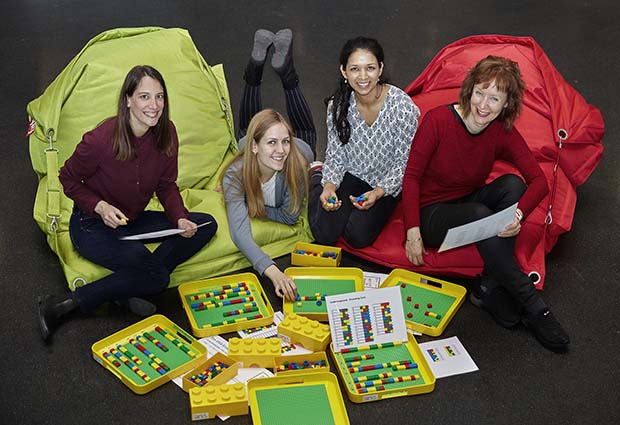
Building engagement
How Lego can help you learn the fundamentals of DNA

Who can resist the lure of a pile of shiny, colourful Lego bricks? The iconic children’s toy has fuelled countless imaginations and furnished the construction of a vast array of complex structures, including detailed replicas of the Kennedy Space Center, London’s Houses of Parliament, and even da Vinci’s Mona Lisa. Yet its individual parts are simple: small plastic bricks that can be joined together. Like Lego, DNA can also be broken down into simple components: organic molecules called nucleotides, or bases, denoted by the letters A, T, C and G.

This similarity dawned on Nick Goldman, group leader and Joint Head of Research at EMBL’s European Bioinformatics Institute (EMBL-EBI), while he was trying to come up with a suitable visual aid to explain how DNA can be used to store digital information. He tested some ideas with his son, who was 14 at the time, and he has since run a number of masterclasses for similar age groups. “For DNA we essentially have four letters of the alphabet, and it occurred to me that you can demonstrate DNA’s information content using four different colours of Lego bricks, without having to create the structure of the DNA or the helix,” he explains. “Lego works incredibly well because you can make it easily, and of course everyone loves playing with Lego.”
Coding at the Technoseum
Last October, the team at EMBL’s European Learning Laboratory for the Life Sciences (ELLS) got to wondering if Goldman’s ideas might be adaptable for an even younger audience. While preparing for a public science day at the Technoseum in Mannheim, Germany, they were quick to realise the appeal of Lego as a public engagement tool. “The theme of the event at the Technoseum was coding, and the obvious focus for us was DNA,” says Agnes Szmolenszky, Head of ELLS. “We knew Nick Goldman had been using Lego for educational purposes, and we took up the idea and developed activities for the science day.”
This was something of an experiment for ELLS in terms of assessing the method’s effectiveness for a young age group, but the activity received an enthusiastic response from both children and adults. Even very young children took part, by working together with older siblings to complete encoding and decoding tasks. “At the Technoseum event, most of the other activities related directly to computer programming,” says Eva Haas, Education Officer at ELLS. “Ours was a little different, so it had novelty value.”
Scalable and adaptable
The ELLS team are now looking at ways of developing the Lego activity for secondary school students (16 years and over), introducing concepts such as mutation and replication. “We like it because it’s very flexible,” says Szmolenszky. “We’re already testing a more advanced version, and we’re thinking about offering this as a hands-on activity as part of our school visitor programme.”
Shweta Gaikwad of ELLS has also used Lego to teach teenagers about the science behind using DNA as an information storage system. “Explaining the science behind DNA can be really simple or really detailed,” she says, “and you can scale the activity up or down for different age groups.”
Every area of scientific endeavour has its own unique challenges. It is perhaps inevitable that when using Lego to teach science to teenagers, a certain proportion of the target audience will ignore the science bit and set about building a castle or a battleship instead. And, reflecting on the scalability of the teaching method, Nick Goldman says wryly, “What’s not scalable is carrying a lot of Lego around. I went over to Belgium once with a suitcase full of Lego – it’s a bit inconvenient!”


